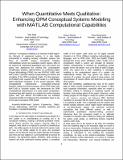When quantitative meets qualitative: enhancing OPM conceptual systems modeling with MATLAB computational capabilities
Author(s)
Dori, Dov; Renick, Aharon; Wengrowicz, Niva
Download163_2015_209_ReferencePDF.pdf (1.830Mb)
PUBLISHER_POLICY
Publisher Policy
Article is made available in accordance with the publisher's policy and may be subject to US copyright law. Please refer to the publisher's site for terms of use.
Terms of use
Metadata
Show full item recordAbstract
Conceptual modeling is an important initial stage in the life cycle of engineered systems. It is also highly instrumental in studying existing unfamiliar systems—the focus of scientific inquiry. Conceptual modeling methodologies convey key qualitative system aspects, often at the expense of suppressing quantitative ones. We present and assess two approaches for solving this computational simplification problem by combining Object-Process Methodology (OPM), the new ISO/PAS 19450 standard, with MATLAB or Simulink without compromising the holism and simplicity of the OPM conceptual model. The first approach, AUTOMATLAB, expands the OPM model to a full-fledged MATLAB-based simulation. In the second approach, OPM computational subcontractor, computation-enhanced functions replace low-level processes of the OPM model with MATLAB or Simulink models. We demonstrate the OPM computational subcontractor on a radar system computation. Experimenting with students on a model of an online shopping system with and without AUTOMATLAB has indicated important benefits of employing this computation layer on top of the native conceptual OPM model.
Date issued
2015-12Department
Massachusetts Institute of Technology. Department of Electrical Engineering and Computer ScienceJournal
Research in Engineering Design
Publisher
Springer London
Citation
Dori, Dov, Aharon Renick, and Niva Wengrowicz. “When Quantitative Meets Qualitative: Enhancing OPM Conceptual Systems Modeling with MATLAB Computational Capabilities.” Research in Engineering Design 27.2 (2016): 141–164.
Version: Author's final manuscript
ISSN
0934-9839
1435-6066